

Digicentral - Plagarism. Taking the Mystery Out of Copyright. Skip navigation Library of Congress Teachers Suggestions enabled.

The Library of Congress > Teachers > Classroom Materials > Presentations and Activities > Copyright Print Subscribe Share/Save Give Feedback Taking the Mystery Out Of Copyright View a plain text version of this activity. Connect with the Library All ways to connect. Paraphrasing: A Writer's Craft Lesson by The Reflective Educator. YouTube. Don't Plagiarizzle - a rap song about plagiarism. Copyright - BrainPOP. Plagiarism - BrainPOP. Copyright4 5.
Library Patch: Citing Sources with Kids. Copyright & Plagiarism for Kids. What Is Plagiarism? Plagiarism Scavenger Hunt. Examples: I would be plagiarizing if I were to write an essay about the walrus and said: The walrus' other characteristic features are equally useful.
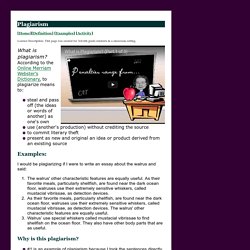
As their favorite meals, particularly shellfish, are found near the dark ocean floor, walruses use their extremely sensitive whiskers, called mustacial vibrissae, as detection devices. As their favorite meals, particularly shellfish, are found near the dark ocean floor, walruses use their extremely sensitive whiskers, called mustacial vibrissae, as detection devices. The walrus' other characteristic features are equally useful.
Teaching Students To Use Textual Evidence. ACT 090213 CommonCore. Musings from the Middle School: Summarizing, Paraphrasing, and Quoting. This year, I decided to teach this skill over a few days at the beginning of the year.

Summarizing, Paraphrasing, and Quoting Texts. We are SO close to being done with our nonfiction unit, and I'm looking forward to jumping back in to novel studies.
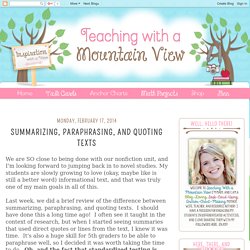
My students are slowly growing to love (okay, maybe like is still a better word) informational text, and that was truly one of my main goals in all of this. Last week, we did a brief review of the difference between summarizing, paraphrasing, and quoting texts. I should have done this a long time ago! I often see it taught in the context of research, but when I started seeing summaries that used direct quotes or lines from the text, I knew it was time. Summarizing Paraphrasing Quoting Text Task Cards by Teaching With a Mountain View. Quoting, Paraphrasing and Summarizing. Protecting Your Digital Footprint. What's your digital footprint? The "New and Improved" Digital Citizenship Survival Kit.
I have been thinking about some "new" items I could add to my original Digital Citizenship Kit that I created last year.

Like I said in that blog post, I love using props when teaching. The Digital Citizenship Survival Kit. It's a simple little prop I use when teaching Digital Citizenship to our K-8 #aurorahuskies students.
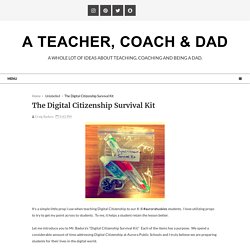
I love utilizing props to try to get my point across to students. To me, it helps a student retain the lesson better. Kidsmart: Digital Footprints. Digital Footprint Resources for FRIT 7234. A Great Guide on Teaching Students about Digital Footprint. Digital Footprints. Posts & replies Due: Jan. 12 (White) Jan. 13 (Blue) Part 1 - Watch the videos & read the articles below - consider the following questions:

Digital Footprint. 5 Ways to Make a Positive Digital Footprint! Follow the Digital Trail (K-2) Digital Citizenship. Program for primary school students. Today’s students live and breathe technology—many know more about it and are more comfortable using it than you are.
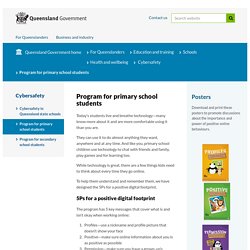
They can use it to do almost anything they want, anywhere and at any time. And like you, primary school children use technology to chat with friends and family, play games and for learning too. 5P’s for a Positive Digital Footprint. Teachers and students learning together in 21st century classrooms are capable of achieving great things.
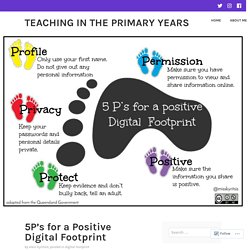
Devices allow students to connect, communicate and collaborate online and publish their work for a global audience. Any content published online will begin to create a digital footprint for each individual. As educators, we need to ensure we model and teach our students how to post content to ensure the digital footprint they are creating is positive in nature. As teachers we have a duty of care for our students. The 5 P’s for a Positive Digital Footprint, developed by the Queensland Government, is a great framework to implement in classrooms.
#frit7234 hashtag. 20 Tips for Creating a Professional Learning Network - Getting Smart by Miriam Clifford. “20 Tips for Creating a Professional Learning Network” by Miriam Clifford first appeared on the InfomED blog.
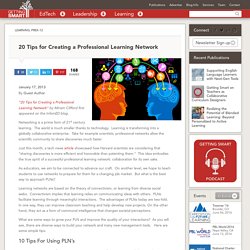
Networking is a prime form of 21st century learning. The world is much smaller thanks to technology. Learning is transforming into a globally collaborative enterprise. Take for example scientists; professional networks allow the scientific community to share discoveries much faster. Just this month, a tech news article showcased how Harvard scientists are considering that “sharing discoveries is more efficient and honorable than patenting them.” FRIT 7234 Resources. Digital Footprint Resources for FRIT 7234. Watch "Revolutionizing Education with Personalized Learning: Jeremy Friedberg at TEDxYouth@Toronto" Video at TEDxTalks. Learning Gets Personal. Have you developed a Personalized Learning Mindset? Several months ago, I read this blog post by Anthony Kim, founder of Education Elements, and the article really resonated with me. White Paper: The Core Four Elements of Personalized Learning: What You Need to Succeed. Erica's Blog. Erica Osher (@MsOsher)
Erica Michelle on Pinterest. Pinterest • The world’s catalog of ideas There’s more to see on Pinterest Come take a look at what else is here! He used Pinterest to start his collection Join Pinterest to discover and save creative ideas. Kath Murdoch (@kjinquiry) The Educator's PLN - The personal learning network for educators. Classroom 2.0. The Reflective Educator — Fashionably Fun in 4th Grade. Kimberly Mitchell (@inquiryfive) Inquiry-Based Learning Commons. Chris Lehmann - Inquiry: The Very First Step In the Process of Learning. Chris Lehmann is the founding principal of the Science Leadership Academy (SLA) in Philadelphia, Pennsylvania. In November of 2012, Chris was named one of Dell's #Inspire100 - one of the 100 people changing the world using Social Media. In April of 2012, Chris won the Lindback Award for Excellence in Principal Leadership in the School District of Philadelphia.
In September of 2011, Chris was honored by the White House as a Champion of Change for his work in education reform. SLA is built on the notion that inquiry is the very first step in the process of learning. Developed in partnership with The Franklin Institute and its commitment to inquiry-based science, SLA provides a rigorous, college-preparatory curriculum with a focus on science, technology, mathematics and entrepreneurship. Inspiring inquiry through picture books. — Kath Murdoch. "The bridge will only take you halfway there, to those mysterious lands you long to see. Educational Leadership:Giving Students Meaningful Work:Even Geniuses Work Hard. Inquiry-based Learning: Explanation. Why It’s Imperative to Teach Students How to Question as the Ultimate Survival Skill. Where the Wonders of Learning Never Cease. Using Photos With English-Language Learners. "A picture is worth a thousand words. " -- Unknown Though the origin of this popular adage is unclear, one thing is clear: using photos with English-Language Learners (ELLs) can be enormously effective in helping them learn far more than a thousand words -- and how to use them.
Usable images for lessons can be found online or teachers and students can take and use their own. The activities presented below connect to multiple Common Core Standards including the following ELA Standards: Integrate and evaluate information presented in diverse media and formats, including visually, quantitatively, and orally. Develop the topic with relevant, well-chosen facts, definitions, concrete details, quotations, or other information and examples. Picture Word Inductive Model.